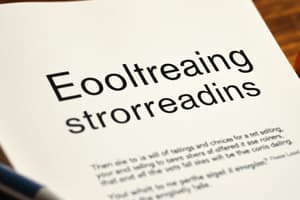Podcast
Questions and Answers
What is the primary goal of proofreading?
What is the primary goal of proofreading?
- To adjust a storyline and build suspense.
- To revise vocabulary choices and sentence structure.
- To review and adjust descriptions for vividness.
- To check for errors in grammar, spelling, punctuation, and formatting. (correct)
What is an important aspect of proofreading for spelling?
What is an important aspect of proofreading for spelling?
- Checking for sentence structure
- Verifying word usage (correct)
- Ensuring proper capitalization
- All of the above
What is the first step in the editing process?
What is the first step in the editing process?
- Proofreading for errors
- Checking grammar and punctuation
- Reviewing and revising vocabulary choices (correct)
- Revising sentence structure
Why is proofreading essential for written communication?
Why is proofreading essential for written communication?
What is an aspect of grammar that proofreaders should double-check?
What is an aspect of grammar that proofreaders should double-check?
What is the primary reason for allowing some time to pass between writing the essay and editing it?
What is the primary reason for allowing some time to pass between writing the essay and editing it?
What is the limitation of relying on spellcheck and grammatical software or online tools?
What is the limitation of relying on spellcheck and grammatical software or online tools?
What is the purpose of reading the essay out loud during the proofreading process?
What is the purpose of reading the essay out loud during the proofreading process?
What is the acronym 'CUPS' commonly used for in proofreading?
What is the acronym 'CUPS' commonly used for in proofreading?
Why is it recommended to proofread an essay in hard copy?
Why is it recommended to proofread an essay in hard copy?
What is a common grammatical error that occurs with verbs?
What is a common grammatical error that occurs with verbs?
What is an example of improper subject and verb agreement?
What is an example of improper subject and verb agreement?
What is the primary focus of proofreaders besides grammar and spelling?
What is the primary focus of proofreaders besides grammar and spelling?
Why is thorough proofreading crucial in academic essays?
Why is thorough proofreading crucial in academic essays?
What is the recommended approach to proofreading?
What is the recommended approach to proofreading?
Flashcards are hidden until you start studying
Study Notes
What is Proofreading?
- Proofreading is the process of ensuring a document is free of errors in grammar, spelling, punctuation, and formatting.
- It is the final step of editing, following the review and revision of vocabulary choices, sentence structure, and other important considerations of effective written communication.
Components of Proofreading
- Spelling:
- Involves correcting errors in word usage, such as transposing letters, mistaking sound combinations, and mistyping.
- Includes proper capitalization and usage of words with the same pronunciation.
- Grammar:
- Involves checking sentence structure, including basic elements like nouns and verbs, and proper placement of adjectives, adverbs, prepositions, conjunctions, etc.
- Includes checking for tense consistency, subject and verb agreement, and other grammatical issues.
Importance of Proofreading
- Proofreading is crucial for academic essays, as it helps students retain credibility among teachers and professors.
- It is essential for building credibility in professional writing, such as company memos, customer correspondence, press releases, and more.
How to Proofread
- Requires careful, slow, and focused reading to uncover errors.
- Involves using standard proofreading marks to indicate corrections, such as underlines for capitalization and carets for insertions.
- Requires reviewing every word, including titles, bylines, headers, and footers.
Proofreading Strategies
- Allow time to pass between writing and editing to approach the work with "fresh eyes".
- Print out a hard copy and use spellcheck and grammatical software or online tools before printing.
- Read the essay out loud, or even backwards, to eliminate context distractions.
- Use a ruler to track lines being read and check for one type of error at a time.
- Consider using a detailed checklist to keep track of proofreading components, such as the "CUPS" acronym (capitalization, usage, punctuation, and spelling).
Studying That Suits You
Use AI to generate personalized quizzes and flashcards to suit your learning preferences.




